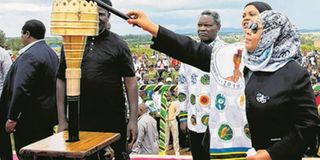NYERERE ANNIVERSARY- ‘Uhuru Torch’: A key tool in struggles for independence

Vice President Samia Suluhu Hassan of the 5th-phase Tanzania government lights the ‘Uhuru Torch’ recently. PHOTO | FILE
What you need to know:
The ‘Uhuru Torch’ was intended to stimulate the struggle for independence for the rest of the seven immediate neighbours of the-then Tanganyika
Arusha. When Mwalimu Julius Kambarage Nyerere (1922-99) sent Captain Alex Nyirenda of the Tanganyika Rifles to light the Uhuru Torch atop Mt Kilimanjaro on the eve of independence in late 1961, he had some justification.
Nearly all the countries sharing borders with Tanganyika were still under colonial rule - with the exception of what was known as Congo Leopoldville - now DR Congo.
The Uhuru (‘Freedom’) Torch was intended to stimulate the struggle for independence for the rest of the seven immediate neighbours of Tanganyika, namely: Kenya, Uganda, Rwanda, Burundi, Northern Rhodesia (Zambia), Nyasaland (Malawi) and Mozambique.
The fruits of the struggle were soon to be realised. In the first place, Tanganyika attained independence the same night, an event likely to have been closed followed by neighbours under the colonial masters..
In a few months, Burundi and Rwanda, which together with Tanganyika were part of the German East Africa, were to follow suit. Both attained independence on the same day in July 1962.
Uganda was to follow in October the same year (1962), Kenya (December 1963) followed in July 1964 by Malawi and Zambia. In between (December 1963), Zanzibar had attained ‘sham’ independence from the Sultan.
Given that Tanganyika, Uganda,Kenya and Zanzibar were under a form of union, being former subjects of the British colonial hegemony, Mwalimu was gunning for an East African Federation comprising the four states.
That was only days or months before independence. Those were the days when Mwalimu, as a leader of the independence struggle in Tanganyika, used to host Kenneth Kaunda and Kamuzu Banda in Mbeya.
On the East African front, he conversed and hosted Jomo Kenyatta and Milton Obote in Dar es Salaam and thereabouts several times, the agenda being how to consolidate regional cooperation after independence.
By 1964, seven of the countries bordering Tanzania had attained independence with the exception of Mozambique under the Portuguese and some island states, notably Comoro which was much closer.
Despite the failure to realize the cherished East African Federation, it was the same year (1964), that Mwalimu’s dreams of uniting Africa made a step forward: the Union between Tanganyika and Zanzibar was realized.
But Tanzania was soon to find itself in the murky waters of the delicate geo-politics of the vast region; encompassing some states in the heart of Africa like Congo, southern Africa and fellow partners in East Africa.
On the EA front, the first cracks of the union started to emerge as each country apparently preferred to go its way from the mid 1960s although the process to launch the East African Community (EAC) was in gear.
Come December 1, 1967 - and the EAC was officially launched in Arusha with its headquarters in the tourism hub which remains the headquarters of the revived EA Community today.
But, for some observers, the Community of the 1967 came too late. The common currency which had united the three states for decades was ditched in favour of each country having its own shilling.
This was followed by complaints of trade and investment imbalances among the three partner states which until then operated joint services like railway, harbours, posts and telecommunications,research institutes and an airline.
Mwalimu’s approach to the emerging challenges was cautious, knowing only too well that it was primarily ideological - given that Tanzania was pursuing a socialist path which did not go down well with some regional leaders.
Matters came to a head in January 1971 when Idi Amin Dada toppled the socialist-leaning government of Dr Obote in Uganda. Mwalimu, who was the Chairman of the East African Authority (a club of the regional presidents similar to today’s EAC Summit) at that time, was explicit from the word go.
He said he would not recogniae the post-Obote government in Kampala.
The bitter hostilities between the two countries fast-tracked the demise of the EAC in 1977 - and culminated in the 1978/79 war which toppled Amin.
On the southern Africa front, Tanzania’s diplomacy was even more challenging. Mwalimu was more pre-occupied with the liberation struggle and had Zambia’s Kenneth Kaunda as his staunchest supporter.
Mozambique, under the Portuguese, posed a security threat to the country - more so after Tanzania openly supported the Frelimo liberation fighters with the necessary logistics.
Many a time, the Portuguese forces raided Tanzania, attacking the freedom fighters’ bases and killing Frelimo leaders such as its President Eduardo Mondlane, eliminated in Dar es Salaam.
Such incursions, rather than scaring the country, galvanised Tanzania’s support and resolve for the liberation struggle for the other states under colonial rule in southern African.
It was also time when Mwalimu started to seek support of the neighbours so that Tanzania was not seen as the only player in the game. Zambia immediately followed Tanzania in providing bases for liberation fighters.
Later, (around 1970), Mwalimu, Kaunda and President Mobulu Sese Seko of Zaire (DR Congo) formed the ‘Mulungushi Club’ to spearhead the fight. It did not last long, as Zaire’s commitment to the struggle - especially its leader Mobutu - was questionable. The Club was replaced by the Frontline States after the independence of Mozambique and Angola.
Frosty relations
But Mwalimu had to deal with frosty relations with the neighbouring Malawi which in the late 1960s had declared it wanted to annex parts of Tanzania’s regions bordering Lake Nyasa.
Tanzania did not see Malawi having the military capability to achieve that. But it was much concerned by the support the latter was getting from the apartheid South Africa to destabilise the liberation efforts.
Relations between the two neighbours were frosty also because Tanzania was the haven of Malawians who fled the autocratic regime of Dr Banda which had strong ties with the Pretoria of those days.
The relations with Malawi remained at the lowest ebb - if not hostile - until 1984 when icy relations started to thaw.
This was later followed by the first and only visit by Dr Banda to Tanzania as a president in 1991!
Economic cooperation was later enhanced when Malawi started to use the Dar es Salaam port for its export/import trade.
Despite being annoyed by some neighbouring states - especially those which used to support the colonial rulers or which undermined Tanzania’s interests in one way or another - Mwalimu would always play it cool.
He would always allow diplomacy to take its way - but would become vocal when bitterly incensed by some neighbours who threatened to annex parts of Tanzania, or those supporting the country’s enemies.




